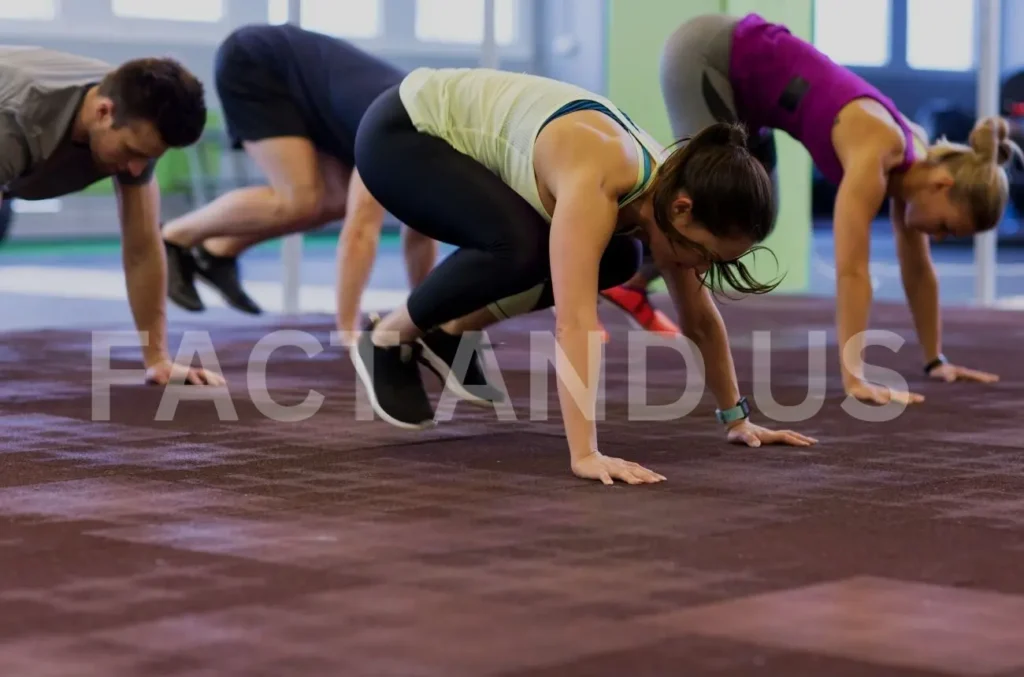Burpee Exercise, a squat thrust with an additional stand between repetitions, is a full body exercise used in strength training. The movement itself is primarily an anaerobic exercise, but when done in succession over a longer period can be utilized as an aerobic exercise.

The basic movement as described by its namesake, physiologist Royal H. Burpee, is performed in four steps from a standing position and known as a “four-count burpee”:
- Move into a squat position with your hands on the ground.
- Kick your feet back into an extended plank position, while keeping your arms extended.
- Immediately return your feet into squat position.
- Stand up from the squat position.
A burpee sounds like something that should be silly. It isn’t. Burpees are brutally efficient as a workout tool, meshing cardio and strength training into an extremely high-intensity package. In seven simple movements, the exercise works your body from top to bottom. It’s a continuous-movement activity that uses the full musculature of your body, says exercise physiologist Griffin Nykor, RKin, CPT. It’s not easy,” says Nykor. “But it is worth it. ”So, let’s get started.
Despite the funny name, and perhaps not being as well-known as pushups or squats, burpees are a challenging exercise that work many of the major muscle groups in your body.
A burpee is essentially a two-part exercise: a pushup followed by a leap in the air. Doing several burpees in a row can be tiring, but this versatile exercise may be worth the payoff, especially if you’re looking for a way to build strength and endurance, while burning calories, and boosting your cardio fitness. Here’s a look at how to do burpees correctly and safely, and variations you can try if you want an easier or more challenging burpee option.

Contents
- 1 Origin
- 2 The benefits of burpees
- 3 How to do burpees
- 4 Begin in a standing position
- 5 How to do a burpee with correct form
- 6 Key tips on burpee form
- 7 How to make it easier
- 8 Burpee exercise variations
- 9 Additions could include:
- 10 Can you make a burpee easier?
- 11 Should some people avoid burpees?
- 12 Safety tips
- 13 The bottom line
- 14 Fun facts about burpees
Origin
The exercise was invented in 1939 by US physiologist Royal Huddleston Burpee Sr., who used it in the burpee test to assess fitness. Burpee earned a PhD in applied physiology from Teachers College, Columbia University in 1940 and created the “burpee” exercise as part of his PhD thesis as a quick and simple fitness test, which may be used as a measure of agility and coordination.
The original burpee was a “four-count burpee” consisting of movements through four different positions, and in the fitness test, the burpee was performed four times, with five heart rate measurements taken before and after the four successive burpees to measure the efficiency of the heart at pumping blood and how quickly the heart rate returns to normal.
The exercise was popularized when the United States Armed Services made it one of the ways used to assess the fitness level of recruits when the US entered World War II. Although the original test was not designed to be performed at high volume, the Army used the burpee to test how many times it can be performed by a soldier in 20 seconds – 8 burpees in 20 seconds is considered poor, 10 is fair, 13 or more excellent. The Army also considered that a soldier fit enough for the rigor of war should be able to perform 40 or 50 burpees non-stop in an easy rhythm.
The benefits of burpees
The toughest exercises check a lot of workout boxes. Burpees certainly do. From an aerobic standpoint, burpees put your ticker to the test. The exercise offers the breath-stealing effect of running in a very condensed timeframe. (Nykor recommends keeping burpee sessions between 30 seconds to 90 seconds.) “You’re going to feel huge peaks in heart rate — and it’s going to happen quickly, given the intensity of the exercise,” explains Nykor. “You’re asking your body to use a lot of energy and a lot of oxygen. “But there’s also a strength, or anaerobic, side to burpees.
Movements within the exercise mesh resistance training with explosive muscle action. A burpee targets your arms, chest and shoulders. It’ll work your abs and tax your leg muscles, hips and gluteus maximus, too. “It’s all-encompassing,” says Nykor. “You’re working everything below the top of your head.”
How to do burpees

Burpees require no equipment and a limited amount of space. Best of all, the exercise can be broken down into seven simple and familiar movements. “There’s nothing particularly tricky about it,” encourages Nykor.
Here are step-by-step instructions. (Warm-up before starting, too.)
Begin in a standing position
Position your feet shoulder-width apart:- Keep your back straight, your chest out and your arms at your sides.
Drop into a squat:- Bend your knees, driving them out slightly past your toes, while bringing your butt down. Keep your feet flat on the floor. Place your hands on the floor (palms down) in front of your feet.
Kick your legs back into a high plank position:- Your body should be in a straight line from shoulders to heels. Lock your arms in place. Keep your head straight, eyes looking slightly ahead. (“You’re going to feel some core activation,” says Nykor.)
Lower toward the ground:- Bend your elbows and bring your body toward the floor. (Basically, the bottom part of a push-up.) Keep your body straight and your core tight.
Rise back to high plank:- Focus on keeping your body straight.
Return to a squat position:- Jump your legs forward. When you land, make sure your feet are flat on the floor. (Your positioning at the end of this move should be the same as in Step 2.)
Jump:- Reach your arms up as you launch toward the ceiling. “It should be an explosive jump,” says Nykor. Land in the original standing position and then go back to Step 1 and restart the process.
How to do a burpee with correct form

Start in a squat position with your knees bent, back straight, and your feet about shoulder-width apart.
Lower your hands to the floor in front of you so they’re just inside your feet.
With your weight on your hands, kick your feet back so you’re on your hands and toes, and in a pushup position.
Keeping your body straight from head to heels, do one pushup. Remember not to let your back sag or to stick your butt in the air.
Do a frog kick by jumping your feet back to their starting position.
Stand and reach your arms over your head.
Jump quickly into the air so you land back where you started.
As soon as you land with knees bent, get into a squat position and do another repetition.
Key tips on burpee form
There are two positions — a squat and high plank — that you reach twice while doing burpees. That makes using proper form doubly important for those steps, stresses Nykor. Let’s look deeper at each.
1) When in the high plank:- make sure to stack your wrists, elbows and shoulders. Don’t put your hands too far forward. “Your bones are stronger than your muscles,” says Nykor. “Use the anatomy of your body to your advantage.”
2) While squatting:- keep your feet flat and resist the urge to come up on your toes. “If your feet are planted firmly, you’ll have a much more stable base,” says Nykor.
How to make it easier
If a standard burpee is too challenging at first, you can make some adjustments to dial down the intensity. Try these variations if you’re new to burpees:
1) Skip the push-up and jump. Start with a squat thrust. It starts out just like a burpee, but instead of doing a pushup and then jumping up, you simply begin in squatting position, kick your legs back so you’re in a pushup position, and then return to your starting stance.
2) Skip the jump. Instead of jumping into the air after the pushup, just return to the squat position.
3) Skip the pushup. If your chest muscles or shoulders aren’t ready for push-ups, hold a plank position for a couple of seconds instead of doing a pushup. You could also do a partial push-up until you build up more strength.
Burpee exercise variations


The instructions above outline your run-of-the-mill burpee. That’s not quite tough enough for some exercise innovators, though. “Modifications to the routine can help keep things fresh,” says Nykor. Examples include using a weighted vest, which can put your muscles to an even greater test, or slipping another movement into the flow of the exercise.
Additions could include:
Adding a “jumping jack” leg split as you do your push-up or to the jump.
Sliding your body into a pike position while in high plank. (Your body will look like an upside-down V.)
Doing a “mountain climber” move from high plank. (Do this by bringing your right knee to your right elbow, then your left knee toward your left elbow.)
Search online for a seemingly endless array of burpee variations, including some that utilize equipment such as a box or a pull-up bar. (A quick note: Many of these modified exercises are more advanced.)
Can you make a burpee easier?
Absolutely, says Nykor. If doing a regular burpee is more demanding than your current fitness level, make adjustments. Maybe that means not doing the jump at the end. Or not doing the push-up. “Do the exercise to your abilities,” advises Nykor. “It’s OK to make changes to burpees to make them more accessible.”
Should some people avoid burpees?
Given the intensity level of the exercise, burpees aren’t ideal for everyone, says Nykor. The heart rate spike may be a concern if you have a heart condition. Nykor recommends getting approval from your doctor or cardiologist before trying the exercise if you’ve had a cardiac event. People with back or hip injuries also may want to avoid the exercise. Ditto for those with shoulder issues, such as a torn rotator cuff.
Safety tips
Like any exercise, burpees are only effective if you do them safely and avoid injury.
Start slowly and just do a few reps at first. Once you get used to the move and can do it easily with no pain, try adding more reps.
Try to work up to doing 8 or 10 reps in a row before pausing, then doing another set.
Because you need to drop to a pushup, burpees can put extra stress on your wrists and shoulders. Be careful not to go so fast that you twist your wrist when you land.
Make sure you have the basic components of the exercise down before you add weights or extra push-up or jumps.
The bottom line
Burpees can be exhausting. What makes them tiring and challenging is what also makes them a highly effective exercise that can help build strength, endurance, and cardio fitness.
If you’re unsure of how to do a burpee, ask a certified personal trainer to help you. Also, if you’re new to exercising or high-intensity interval training, or if you have a health condition, talk to your healthcare provider first to make sure burpees are safe for you.
Fun facts about burpees
A fitness innovator named Royal H. Burpee mapped out the exercise in 1939 as a quick-and-simple way to assess a person’s fitness. He developed it as part of his PhD thesis at Columbia University. (He passed, of course.) A few years later, the U.S. military used Burpee’s exercise to assess new soldiers and gauge whether they could handle the physical rigors of combat. And while the exercise is usually done in short bursts, some go for the long haul. The Guinness World Record for most burpees in 24 hours is 12,003 by an Australian woman named Eva Clarke. (The male record is 10,815.)
Stay connected with Fact and US for more such news.
